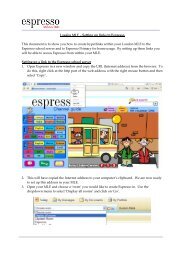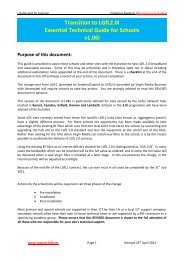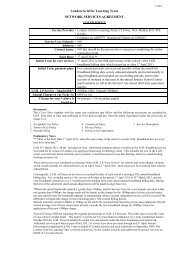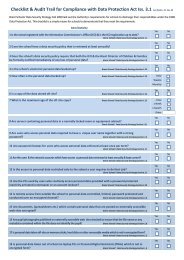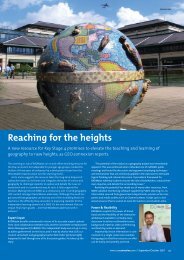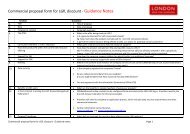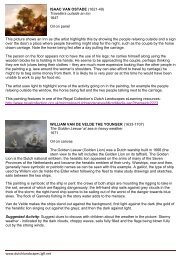Say no to bullying
Say no to bullying
Say no to bullying
Create successful ePaper yourself
Turn your PDF publications into a flip-book with our unique Google optimized e-Paper software.
Ask the children whether they think the soldiers hurting him, or <strong>no</strong>t being allowed<strong>to</strong> go <strong>to</strong> the party, was worse for Humpty. Refer <strong>to</strong> the lists of <strong>bullying</strong> behavioursthat the children produced before the assembly at the beginning of the week.Have the children rate how bad they think each sort of behaviour is. Comparetheir responses.Point out <strong>to</strong> the children that one sort of <strong>bullying</strong> is <strong>no</strong>t necessarily worse thana<strong>no</strong>ther just because, for example, it involves hurting someone physically. Talk <strong>to</strong>the children about how hurting people on the ‘inside’ by words or other sorts ofnastiness can last longer and make you feel worse. Only the person being bulliedreally k<strong>no</strong>ws what is worse for them. For some people it will be if someone makesfun of them, for a<strong>no</strong>ther person if someone leaves them out of a game. Discussthe rhyme ‘Sticks and s<strong>to</strong>nes may break my bones, but words will never hurt me’.Is it true?Ask why Humpty did <strong>no</strong>t tell about the <strong>bullying</strong>. Scribe their ideas.<strong>Say</strong> that one reason why people sometimes don’t tell is because they think thatthe <strong>bullying</strong> is somehow ‘their fault’ for being different in some way. This is <strong>no</strong>ttrue as we are all the same and different in many ways.We wanted <strong>to</strong> domore on how weare the same anddifferent. We askedthe children <strong>to</strong> findsomeone: ‘who hasdifferent hair colour<strong>to</strong> you’, ‘who likesthe same food asyou’, ‘who has thesame skin colouras you’, ‘who hasthe same numberof brothers andsisters’, ‘whosename starts with adifferent sound ’.If someone is bullied, it is the person doing the <strong>bullying</strong> who has decided that thedifference matters. Plenty more people will be different in the same way but <strong>no</strong>tbe bullied.‘Why is it good <strong>to</strong> tell?’‘How can we encourage people <strong>to</strong> tell if they are bullied?’Make a list of all the people in the school who the children would tell if they wereunhappy or being bullied. Ask how they would explain what was happening.Quiz: is it <strong>bullying</strong>?Remind the children about the questions which they can ask themselves <strong>to</strong>decide if <strong>bullying</strong> is going on. Then read out the four scenarios below, using thepictures in the resource sheets <strong>to</strong> support the children’s understanding. Ask them<strong>to</strong> decide which ones are <strong>bullying</strong>. Compare and talk about their responses.Alternatively, ask groups of children <strong>to</strong> role-play one of the situations while the res<strong>to</strong>f the class offer their views on whether it is <strong>bullying</strong> or <strong>no</strong>t.We reminded thechildren that someof the children i<strong>no</strong>ur school usedcards <strong>to</strong> say ‘s<strong>to</strong>p’and ‘help’, andthen designed one<strong>to</strong>gether <strong>to</strong> say ‘Ifeel like I am beingbullied’.• In the nursery, Farozea has the job of giving out the aprons for the waterplay,and she always chooses the same children. Every day Delvin asks if he canplay, but she always says ‘No. Only girls can play’.• Richard and Kevin are in the same class and play <strong>to</strong>gether every playtime. Oneday they have an argument over a football in the playground. Richard pushesKevin and he cries and tells the teacher.• Errol and his friends stand in the <strong>to</strong>ilets at playtime and don’t let the youngerchildren use them.• Yingmei has got lots of friends and she tells them all <strong>no</strong>t <strong>to</strong> let Suki play withthem at playtime because she smells.Get the children <strong>to</strong> draw or paint the people who they listed in the earlier activity –those who they could tell if they felt that they were being bullied, and why. Usespeech bubbles <strong>to</strong> show the words they could use. Compile a class book ofthese people. 9© Crown copyright 2005 <strong>Say</strong> <strong>no</strong> <strong>to</strong> <strong>bullying</strong> Years 1 and 2DfES 1340-2005Primary National Strategy




